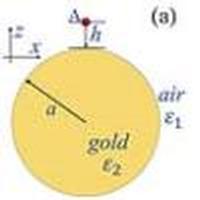当前位置:
X-MOL 学术
›
Opt. Express
›
论文详情
Our official English website, www.x-mol.net, welcomes your feedback! (Note: you will need to create a separate account there.)
Bound state and non-Markovian dynamics of a quantum emitter around a surface plasmonic nanostructure
Optics Express ( IF 3.8 ) Pub Date : 2020-02-19 , DOI: 10.1364/oe.386828 Sha-Sha Wen , Yong-Gang Huang , Xiao-Yun Wang , Jie Liu , Yun Li , Xiu-E Quan , Hong Yang , Jin-Zhang Peng , Ke Deng , He-Ping Zhao
Optics Express ( IF 3.8 ) Pub Date : 2020-02-19 , DOI: 10.1364/oe.386828 Sha-Sha Wen , Yong-Gang Huang , Xiao-Yun Wang , Jie Liu , Yun Li , Xiu-E Quan , Hong Yang , Jin-Zhang Peng , Ke Deng , He-Ping Zhao

|
A bound state between a quantum emitter (QE) and surface plasmon polaritons (SPPs) can be formed, where the excited QE will not relax completely to its ground state and is partially stabilized in its excited state after a long time. We develop some theoretical methods for investigating this problem and show how to form such a bound state and its effect on the non-Markovian decay dynamics. We put forward an efficient numerical approach for calculating the analytical part of the self-energy for frequency below the lower energy threshold. We also propose an efficient formalism for obtaining the long-time value of the excited-state population without calculating the eigenfrequency of the bound state or performing a time evolution of the system, in which the probability amplitude for the excited state in the steady limit is equal to one minus the integral of the evolution spectrum over the positive frequency range. With the above two quantities obtained, we show that the non-Markovian decay dynamics of an initially excited QE can be efficiently obtained by the method based on the Green’s function expression for the evolution operator when a bound state exists. A general criterion for identifying the existence of a bound state is presented. The performances of the above methods are numerically demonstrated for a QE located around a metal nanosphere and in a gap plasmonic nanocavity. Numerical results show that these methods work well and the QE becomes partially stabilized in its excited state at a long time for the transition dipole moment beyond its critical value. In addition, it is also found that this critical value is heavily dependent on the distance between the QE and the metal surface, but nearly independent on the size of the nanosphere or the rod. Our methods can be utilized to understand the suppressed decay dynamics for a QE in an open quantum system and provide a general picture on how to form such a bound state.
中文翻译:

围绕表面等离子体纳米结构的量子发射体的束缚态和非马氏动力学
可以在量子发射器(QE)和表面等离激元极化子(SPPs)之间形成束缚态,其中激发的QE不会完全松弛到其基态,并且经过长时间后会部分稳定在激发态。我们开发了一些用于研究此问题的理论方法,并展示了如何形成这种束缚态及其对非马尔可夫衰变动力学的影响。我们提出了一种有效的数值方法,用于计算低于较低能量阈值的频率的自能量的解析部分。我们还提出了一种有效的形式主义,用于获得激发态总体的长期值,而无需计算束缚态的本征频率或执行系统的时间演化,其中在稳态极限中激发态的概率幅度等于1减去在正频率范围内演化谱的积分。利用获得的上述两个量,我们表明,当存在束缚态时,通过基于格林函数表达式的演化算子的方法可以有效地获得初始激发QE的非马氏衰减动力学。提出了识别结合状态存在的一般标准。对于位于金属纳米球周围和间隙等离子体纳米腔中的QE,数值方法证明了上述方法的性能。数值结果表明,这些方法效果很好,并且当跃迁偶极矩超过其临界值时,QE长时间稳定在其激发态。此外,还发现该临界值在很大程度上取决于QE与金属表面之间的距离,但几乎与纳米球或棒的大小无关。我们的方法可用于了解开放量子系统中QE的抑制衰减动力学,并提供有关如何形成这种束缚态的一般图片。
更新日期:2020-03-02
中文翻译:

围绕表面等离子体纳米结构的量子发射体的束缚态和非马氏动力学
可以在量子发射器(QE)和表面等离激元极化子(SPPs)之间形成束缚态,其中激发的QE不会完全松弛到其基态,并且经过长时间后会部分稳定在激发态。我们开发了一些用于研究此问题的理论方法,并展示了如何形成这种束缚态及其对非马尔可夫衰变动力学的影响。我们提出了一种有效的数值方法,用于计算低于较低能量阈值的频率的自能量的解析部分。我们还提出了一种有效的形式主义,用于获得激发态总体的长期值,而无需计算束缚态的本征频率或执行系统的时间演化,其中在稳态极限中激发态的概率幅度等于1减去在正频率范围内演化谱的积分。利用获得的上述两个量,我们表明,当存在束缚态时,通过基于格林函数表达式的演化算子的方法可以有效地获得初始激发QE的非马氏衰减动力学。提出了识别结合状态存在的一般标准。对于位于金属纳米球周围和间隙等离子体纳米腔中的QE,数值方法证明了上述方法的性能。数值结果表明,这些方法效果很好,并且当跃迁偶极矩超过其临界值时,QE长时间稳定在其激发态。此外,还发现该临界值在很大程度上取决于QE与金属表面之间的距离,但几乎与纳米球或棒的大小无关。我们的方法可用于了解开放量子系统中QE的抑制衰减动力学,并提供有关如何形成这种束缚态的一般图片。



























 京公网安备 11010802027423号
京公网安备 11010802027423号